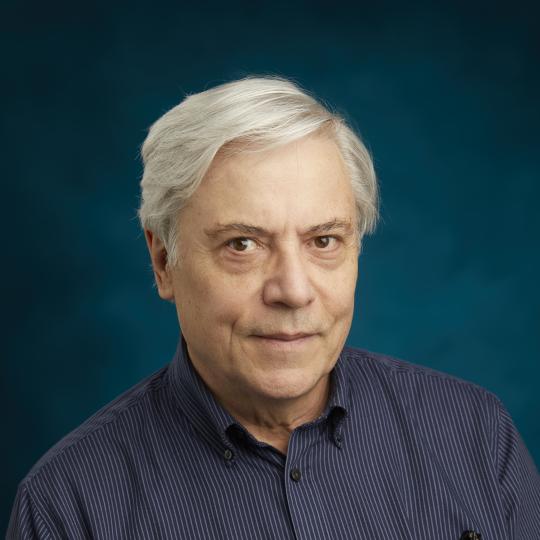
Julio Copello, PhD
About me
Contact
Julio Copello <jcopello@siumed.edu>
Research Interest and Specialties
Calcium Homeostasis in Striated Muscle in Health and Disease
Electrical excitation of muscle and heart cells rapidly induce and increase in cytosolic calcium that activate contractility as required for the heartbeat and for muscle-induced movements. Approximately 5% of the cellular volume of muscle and heart cells is dedicated to intracellular organelles specialized in calcium storage (the sarcoplasmic reticulum [SR]). Upon electrical excitation, the SR briefly puffs calcium into the cytosol for triggering cellular contraction. This is mediated by the opening of gates in calcium-permeable channel molecules named ryanodine receptors (RyRs) of the SR. Contraction terminates when calcium is removed back to the SR, via a process that requires energy (ATP) and is mediated by a "calcium pump", namely the "calcium ATPase of SR" (SERCA).
A proper function of RyRs is fundamental for life as even mild dysfunction of intracellular calcium homeostasis associates with diseases of the heart (arrhythmia, ischemic damage) and skeletal muscle diseases (malignant hyperthermia, central core disease). We study the function of RyRs and we have found that these channels have unique characteristics as they associate in arrays and work in synchrony. That is, they open their pores in unison to allow calcium to move from the SR store to the cytosol and then, all RyRs close their pores at once (i.e., within microseconds). We name this behavior as "coupled gating" and our aim is understanding the phenomenon, including the nature of the physical RyR-RyR interactions that induce coupling, function under physiological versus pathological conditions and pharmacological regulation. We have established collaborations for concurrent cellular studies with Dr. Marino DiFranco (School of Medicine - UCLA) and Dr. Ariel Escobar (School of Engineering - UC Merced) for contrasting our "in vitro" channel studies with measures of calcium dynamics at the cellular level, to better understand how changes in channel function could impact the whole process of calcium homeostasis in the dynamic and complex environments of skeletal muscle versus heart cells. As example, Dr. A. Escobar (University of California - Merced) has determined that during ischemic events (lack of blood flow), calcium do not exit but accumulates in the SR (overload). After blood flow to the tissue is restored (required for survival) the overloaded SR releases massive amounts of calcium to the cytosol that trigger proteolysis and apoptosis of heart cells (ischemia reperfusion injury). Our channels studies explain the observation by showing that under acidosis as in ischemia RyRs are inactive and do not release calcium from SR. Then, when the pH rapidly normalizes (restoration of blood flood), the RyRs reactivated to exacerbated levels due to the calcium overload. Our goal is to carry out channel and cell studies to determine changes/abnormalities of calcium homeostasis under physiological aging, as well as, upon pathologies (i.e., ischemia, acidosis, metabolic syndrome).
Despite the crucial role RyRs play for heart and muscle ischemic diseases, there are no FDA approved drugs that directly modulate these channels. Consequently, another goal is to uncover chemical compounds (synthetic and natural agents) to modulate the RyRs for preventing release during reperfusion of ischemic tissues (both in muscles and heart). We also search for drugs that would indirectly modulate RyRs and our focus is on SERCA, the calcium pump that mediates the SR overload in ischemia. We have found that various cell protective drugs target SERCA (which may prevent overload). Thus, we think that partially inhibiting its pumping activity could be protective in ischemic events.
Calcium Homeostasis in Cancer Cells
Calcium is known to trigger many cellular processes that are exacerbated (metabolism, cell mobility, growth & division) or inhibited (differentiation, apoptosis/necrosis) in cancer cells. Since 2014, I am collaborating with Dr. Tischkau towards the understanding on how modulation of intracellular calcium homeostasis by environmental conditions and drugs could affect cell cancer survival and growth. Initial studies focused on understanding if cell protective drugs that target SERCA also protect cancer cells. Currently, we are expanding this project to include the understanding on how the impact of calcium transporters to calcium homeostasis correlates with different stages of differentiation/invasiveness of cancer cells.
Gender
Education & training
Publications
Darcy YL, Diaz-Sylvester PL, Copello JA.K201 (JTV519) is a Ca2+-Dependent Blocker of SERCA and a Partial Agonist of Ryanodine Receptors in Striated Muscle. Mol Pharmacol. 2016; 90:106-115. PMID: 27235390
Diaz-Sylvester PL, Porta M, Juettner VV, Lv Y, Fleischer S, Copello JA. Eudistomin D and penaresin derivatives as modulators of ryanodine receptor channels and sarcoplasmic reticulum Ca2+ ATPase in striated muscle. Mol Pharmacol. 2014; 85: 564-575. PMID: 24423447.
Porta M, Diaz-Sylvester PL, Neumann JT, Escobar AL, Fleischer S, Copello JA. Coupled gating of skeletal muscle ryanodine receptors is modulated by Ca2+, Mg2+, and ATP. Am J Physiol Cell Physiol. 2012; 303: C682-697. PMID: 22785120.
Diaz-Sylvester PL, Porta M, Copello JA. Modulation of cardiac ryanodine receptor channels by alkaline earth cations. PLoS One. 2011; 6(10):e26693. Epub 2011 Oct 21. PMID:22039534
Neumann JT, Copello JA. Cross-reactivity of ryanodine receptors with plasma membrane ion channel modulators. Mol Pharmacol. 2011; 80: 509-517. PMID:21665944
Porta M, Zima AV, Nani A, Diaz-Sylvester PL, Copello JA, Ramos-Franco J, Blatter LA, Fill M. Single ryanodine receptor channel basis of caffeine's action on Ca2+ sparks. Biophys J. 2011; 100: 931-938. PMID: 21320437.
Neumann JT, Diaz-Sylvester PL, Fleischer S, Copello JA. CGP-37157 inhibits the sarcoplasmic reticulum Ca2+ ATPase and activates ryanodine receptor channels in striated muscle. Mol Pharmacol. 2011; 79: 141-147. PMID: 20923851.
Johnson SR, Copello JA, Evans MS, Suarez AV. A biochemical characterization of the major peptides from the Venom of the giant Neotropical hunting ant Dinoponera australis. Toxicon. 2010; 55:702-710. PMID: 19879289
Ramos-Franco J, Gomez AM, Nani A, Liu Y, Copello JA, Fill M. Ryanodol action on calcium sparks in ventricular myocytes. Pflugers Arch. 2010; 460: 767-776. PMID: 20419313.
